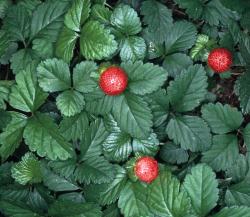- Taxon
- Gallery
- ≡ Fragaria indica Andrews (1806)
- ≡ Duchesnea indica (Andrews) Focke (1888)
Herb with short stock, somewhat flaccid, up to 10–(15) cm high at flowering; runners greenish, slender, pilose, up to c. 50 cm long and rooting at nodes and tips to form new rosettes. Basal lvs several in rosette; petiole 30–80–(160) mm long, densely pilose; leaflets obovate to narrowly ovate, subacute, obtuse to cuneate at base, bright green above, paler below, usually sparsely to moderately pilose on both surfaces especially along veins, sometimes with only scattered hairs on upper, with margins crenate to obscurely lobed; terminal leaflet 15–55 × 12–30 mm; lateral leaflets = terminal or slightly smaller; petiolules 1–5 mm long, pilose. Scape often only slightly exceeding lvs, pilose. Epicalyx segments broadly obovate, pilose, deflexed at fruiting, with 3–5 purple-tipped teeth. Sepals ovate-triangular, c. 6–10 mm long, acuminate, purple-tipped, pilose. Petals narrowly obovate, 4–8 mm long, ± = epicalyx segments and sepals, shallowly emarginate to rounded, spreading, bright yellow. Achenes uniformly scattered over and projecting from receptacle; receptacle red, swollen, up to 12 mm long, often slightly constricted near base.
[From: Webb et al. (1985) Flora of New Zealand. Volume 4 as Duchesnea indica (Andrews) Focke]




